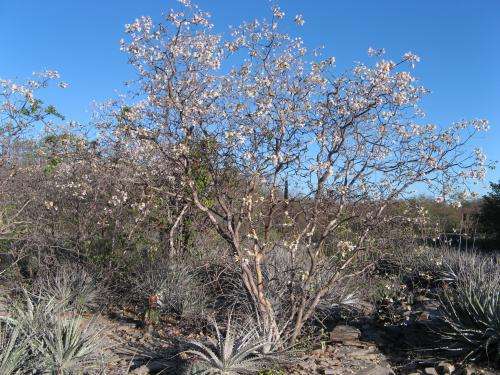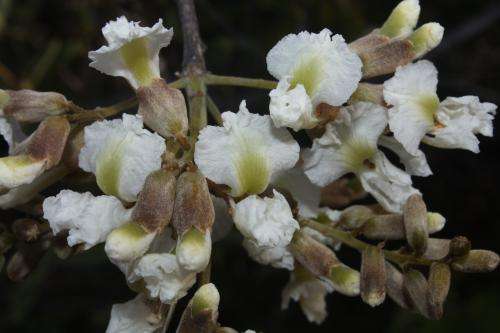Don't be fooled: Flowers mislead traditional taxonomy

For hundreds of years, plant taxonomists have worked to understand how species are related. Until relatively recently, their only reliable source of information about these relationships was the plants' morphology—traits that could be observed, measured, counted, categorized, and described visually. And paramount among these morphological traits were aspects of flower shape and arrangement.
In the papilionoid legumes—a large, diverse group that includes the common pea and bean—most species have highly specialized, "butterfly-shaped" flowers with bilateral symmetry, fused stamens, and strongly differentiated standard, wing, and keel petals. Papilionoid genera with radially symmetric or weakly differentiated flower parts have been regarded as primitive members of the group. However, an international team of researchers have found that floral morphologies may be less reliable than other traits in determining the relationships of papilionoid species and genera. Their findings can be found in the recent issue of the American Journal of Botany.
Lead author Domingos Cardoso (Universidade Estadual de Feira de Santana in Bahia, Brazil) was intrigued by the floral diversity of papilionoid legumes. Growing up in the Caatinga region—a unique dry woodland biome in northeastern Brazil with many endemic legume species—Cardoso was fascinated by the beautiful mass flowering of leafless Luetzelburgia trees during the dry season. Despite their abundance in the Caatinga,Luetzelburgia species were poorly represented and often misidentified in herbaria. Furthermore, taxonomists had generally regarded Luetzelburgia and the putatively related Sweetia as primitive papilionoid groups because they lack the characteristic papilionate flowers. Yet, evidence from DNA sequences suggested that these plants were closely related to two rainforest genera with true papilionate flowers, Vatairea and Vataireopsis.

To understand the taxonomy and relationships of Luetzelburgia and its relatives, Cardoso set out to examine herbarium specimens and collect new specimens from across the geographic range of the genera. One challenge: the only previous taxonomic study of Luetzelburgia was published in Russian! Once the bibliographies were translated, another challenge arose: these legume genera extend over much of South America, with specimens from very different biomes often identified as the same species in herbaria. In 15 days, Cardoso and two friends drove about 5000 miles from northeastern Argentina to the Bolivian Chiquitano dry forest and the Andean Altiplano in La Paz. This field and herbarium research confirmed two new species of Luetzelburgia in Bolivia.
Despite their striking differences in flower shape, Luetzelburgia, Sweetia, Vatairea, and Vataireopsis turned out to be close relatives. Moreover, the two genera with papilionate flowers were not each other's closest relatives. According to Cardoso, "We showed that similarity in floral morphology does not predict phylogenetic relatedness. Indeed, genera with very different flower shapes are often very closely related (Luetzelburgia and Vatairea), and genera with highly similar flowers share such similarity via convergent evolution (Vatairea and Vataireopsis)."
For these plants, other morphological characteristics may indicate relationships more reliably. "Floral traits are apparently more prone to rapid evolutionary changes in response to local ecological conditions," Cardoso said, "whereas vegetative and fruiting traits are more conserved and not readily shaped by local conditions."
Taxonomists beware: the flowers might just be fooling us.
More information: Cardoso, Domingos, Luciano Paganucci de Queiroz, Haroldo Cavalcante de Lima, Elisa Suganuma, Cássio van den Berg, and Matt Lavin. 2013. A molecular phylogeny of the vataireoid legumes underscores floral evolvability that is general to many early-branching papilionoid lineages. American Journal of Botany 100(2): 403-421. DOI: 10.3732/ajb.1200276
Journal information: American Journal of Botany
Provided by American Journal of Botany














.jpg)





